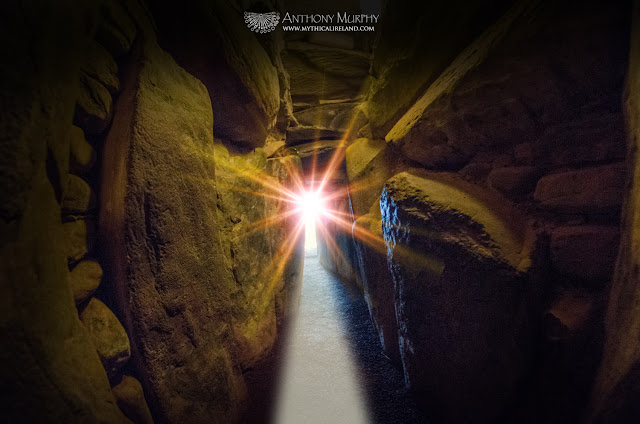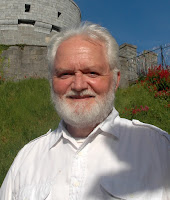
Do the myths about Newgrange and the Boyne Valley mounds offer an insight into their function?
"Myths are just stories," a historian once told me. As far as he was concerned, they were stories that were made up for sheer entertainment. In that mindset, myths are not metaphors for anything, and they certainly don't contain detail about real history, or any information such as astronomical data.
However, students of mythology know the truth is much more complex than that. Many myths are metaphorical. Some do refer to actual events. And there are stories that appear, in certain interpretations, to contain astronomical information.
My own view is that myths should never be dismissed as mere stories. However, the truth is that in most cases we can only travel so far along the road of hypothesis and speculation, no matter how well grounded it is, because often we are unable to discern the true age of a myth, or how it might have been altered by the voices of time.
In the case of Newgrange, Dowth and Knowth (the former two in particular), there are myths and folk tales that appear to offer a tantalising possibility - that they contain information about these sites and the function of these monuments that might go all the way back into deep prehistory. And so I will discuss some of these myths and folk beliefs in the context of possibility only - without drawing any definitive conclusions, except to acknowledge at the outset that I am excited about the possibilities, which may tinge my investigation with a hint of subjectivity.
I've written in several publications about the Venus connection at Newgrange. Joseph Campbell, writing in The Masks of God: Primitive Mythology, referred to a local story that suggested that at sunrise on one day in eight years, the morning star rises and casts its beam into the chamber. This story was recounted, it would appear, before the excavation and restoration of Newgrange in the 1960s, work which resulted in the leading archaeologist Michael O'Kelly witnessing, in 1967, the light from the winter solstice sun entering the chamber. Prior to the restoration, neither sun nor Venus (nor any heavenly body) could be seen from the chamber because of the subsidence of the passage cap stones during the five millennia since Newgrange was constructed.
Of particular intrigue is the fact that archaeologists maintain Newgrange was "sealed up" within a few centuries of being built after cairn material slipped off the top and covered the kerb and entrance, and that its passage and chamber lay concealed for about four millennia until local landowner Charles Campbell rediscovered the entrance in 1699AD.
Another folk belief in the 1930s, recounted recently in this blog, told how the Tuatha Dé Danann brought stones from the Mourne Mountains for the building of the mounds. During the excavations in the 1960s, it was indeed discovered that there were water-rolled granite cobbles at Newgrange (which had been hidden beneath the cairn slip). These, it has been revealed, came from the Cooley Peninsula, but have their origin in the Mournes.
In his 1990 paper, Time, Memory, and the Boyne Necropolis, John Carey examined aspects of two stories - one about Newgrange and one about Dowth. The Newgrange story, from Tochmarc Étaíne, The Wooing of Étaíne, tells of how the Dagda sent Elcmar away so that he might have illicit relations with Elcmar's wife, Bóinn. The Dagda worked a magic spell, so that Elcmar would seem that he is away for a single day, when in fact he had been away for nine months. Dagda lay with Bóinn and the child Oengus Óg was conceived and born. The Dowth story, from the Dindshenchas, told how the king, Bresal, had brought the men of Ireland to build him a tower to reach heaven. The king's sister cast a spell on the sun to make it stand still, so there would be endless day to allow the tower be built.
Carey makes a very interesting observation: "I am aware of no Irish legends associating the control or construction of sacred sites with the manipulation of time other than those which concern the tumuli of the Boyne valley."
In the tale Altram Tighe Dá Mheadar (The Fosterage of the House of Two Vessels), Manannán advises Oengus on how to take Newgrange from Elcmar: "Command him not to come (again) to the house from which he departs until ogam and achu are mingled together, until heaven and earth are mingled together, and until the sun and moon are mingled together." The mingling of heaven and earth could imply the mating of sky with the earth-mound Newgrange during winter solstice, while the latter reference to sun and moon being mingled might refer to an eclipse, something that I think is implied in the story about Dowth, in which the magic spell on the sun is broken when Bresal commits incest with his sister and a sudden darkness comes upon the land. (For further discussion of this theory, see Island of the Setting Sun, chapter 6.) I have discussed at length on the Mythical Ireland website and in my books the idea that the mound builders were competent astronomers, whose knowledge of the complex movements of the moon (and by extension the predictable patterns of eclipses) were recorded in stone, and inherent in the design of the monuments.
Writing in 2009, Ronald Hicks of Ball State University suggested, in a paper entitled Cosmography In Tochmarc Étaíne, that the story of The Wooing of Étaíne was "meant as an allegory about lunar cycles in which Étaín represents the moon". These lunar cycles, writes Hicks, include the 19-year Metonic Cycle, which was"likely to have been of interest to the ancient Irish".
In one part of The Wooing of Étaín, Midir's wife Fuamnach became jealous of her husband's new wife, Étaín. By magic, Fuamnach turned Étaín into a butterfly (some versions say a fly) and raised a storm that buffeted the butterfly around Ireland for seven years.
There is only one "window" at Newgrange - the sky window, or roof box, as it's more commonly known. This aperture allows the sun to shine into the chamber on winter solstice. Perhaps the "sunny bower" is the chamber of Newgrange, illuminated by the rays of the rising sun on Winter Solstice. I discuss this and some of the other above mentioned myths about Newgrange in this video:
 |
| The winter solstice illumination of Newgrange by the sun. Composite © Anthony Murphy. |
However, students of mythology know the truth is much more complex than that. Many myths are metaphorical. Some do refer to actual events. And there are stories that appear, in certain interpretations, to contain astronomical information.
My own view is that myths should never be dismissed as mere stories. However, the truth is that in most cases we can only travel so far along the road of hypothesis and speculation, no matter how well grounded it is, because often we are unable to discern the true age of a myth, or how it might have been altered by the voices of time.
In the case of Newgrange, Dowth and Knowth (the former two in particular), there are myths and folk tales that appear to offer a tantalising possibility - that they contain information about these sites and the function of these monuments that might go all the way back into deep prehistory. And so I will discuss some of these myths and folk beliefs in the context of possibility only - without drawing any definitive conclusions, except to acknowledge at the outset that I am excited about the possibilities, which may tinge my investigation with a hint of subjectivity.
 |
| Newgrange, Knowth and Dowth. Images by the author. |
 |
| Joseph Campbell |
Of particular intrigue is the fact that archaeologists maintain Newgrange was "sealed up" within a few centuries of being built after cairn material slipped off the top and covered the kerb and entrance, and that its passage and chamber lay concealed for about four millennia until local landowner Charles Campbell rediscovered the entrance in 1699AD.
Another folk belief in the 1930s, recounted recently in this blog, told how the Tuatha Dé Danann brought stones from the Mourne Mountains for the building of the mounds. During the excavations in the 1960s, it was indeed discovered that there were water-rolled granite cobbles at Newgrange (which had been hidden beneath the cairn slip). These, it has been revealed, came from the Cooley Peninsula, but have their origin in the Mournes.
In his 1990 paper, Time, Memory, and the Boyne Necropolis, John Carey examined aspects of two stories - one about Newgrange and one about Dowth. The Newgrange story, from Tochmarc Étaíne, The Wooing of Étaíne, tells of how the Dagda sent Elcmar away so that he might have illicit relations with Elcmar's wife, Bóinn. The Dagda worked a magic spell, so that Elcmar would seem that he is away for a single day, when in fact he had been away for nine months. Dagda lay with Bóinn and the child Oengus Óg was conceived and born. The Dowth story, from the Dindshenchas, told how the king, Bresal, had brought the men of Ireland to build him a tower to reach heaven. The king's sister cast a spell on the sun to make it stand still, so there would be endless day to allow the tower be built.
 |
| The myths of the Boyne monument appear to indicate control of time. |
Carey makes a very interesting observation: "I am aware of no Irish legends associating the control or construction of sacred sites with the manipulation of time other than those which concern the tumuli of the Boyne valley."
In the tale Altram Tighe Dá Mheadar (The Fosterage of the House of Two Vessels), Manannán advises Oengus on how to take Newgrange from Elcmar: "Command him not to come (again) to the house from which he departs until ogam and achu are mingled together, until heaven and earth are mingled together, and until the sun and moon are mingled together." The mingling of heaven and earth could imply the mating of sky with the earth-mound Newgrange during winter solstice, while the latter reference to sun and moon being mingled might refer to an eclipse, something that I think is implied in the story about Dowth, in which the magic spell on the sun is broken when Bresal commits incest with his sister and a sudden darkness comes upon the land. (For further discussion of this theory, see Island of the Setting Sun, chapter 6.) I have discussed at length on the Mythical Ireland website and in my books the idea that the mound builders were competent astronomers, whose knowledge of the complex movements of the moon (and by extension the predictable patterns of eclipses) were recorded in stone, and inherent in the design of the monuments.
 |
| Prof. Ronald Hicks |
In one part of The Wooing of Étaín, Midir's wife Fuamnach became jealous of her husband's new wife, Étaín. By magic, Fuamnach turned Étaín into a butterfly (some versions say a fly) and raised a storm that buffeted the butterfly around Ireland for seven years.
At last, however, a chance gust of wind blew her through a window of the fairy palace of Angus on the Boyne. The immortals cannot be hidden from each other, and Angus knew what she was. Unable to release her altogether from the spell of Fuamnach, he made a sunny bower for her, and planted round it all manner of choice and honey-laden flowers, on which she lived as long as she was with him, while in the secrecy of the night he restored her to her own form and enjoyed her love.
There is only one "window" at Newgrange - the sky window, or roof box, as it's more commonly known. This aperture allows the sun to shine into the chamber on winter solstice. Perhaps the "sunny bower" is the chamber of Newgrange, illuminated by the rays of the rising sun on Winter Solstice. I discuss this and some of the other above mentioned myths about Newgrange in this video:
